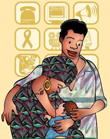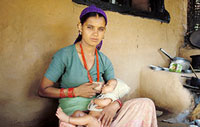
|
Home | Research and Links | HIV and Breastfeeding News | Videos | Zithromax in Italia
July 2018 — The risk of HIV virus transmission from mother to child is a major challenge to optimal breastfeeding practices. However, this risk is minimised through the availability of prevention, family planning, early detection/testing, effective lifelong treatment with antiretrovirals along with appropriate infant feeding practices and consistent support. The known benefits of breastfeeding to reduce mortality from other infections justify an approach that strongly recommends the option of breastfeeding plus ARVs as the standard of care.WABA is proud to launch the Understanding International Policy on HIV and Breastfeeding: A Comprehensive Resource. This Kit provides information on the concepts and recommendations for dealing with infant feeding and HIV. With this Kit, we can empower and support women in their own efforts to make informed choices and create a more enabling environment in which to breastfeed. What makes Cialis 10mg the best ED drug? Read on to find out why.This website contains a HIV Kit that provides an overview of infant feeding in the context of HIV. There are six sections, with information, issues to think about and to discuss, actions to take and contacts for further resources.This Kit (2nd Edition, 2018) provides an overview of infant feeding in the context of HIV, based on current evidence (2018). The Kit contains information, issues to think about and discuss, actions to take and references. The Kit may serve as a useful tool for anyone who works with mother-child dyads in areas where HIV is endemic.This document is endorsed by the Academy of Breastfeeding Medicine. We hope the Kit will be distributed widely to help mother-child dyads in reaching their breastfeeding goals, which could lead to a reduction in morbidity and mortality related to HIV.
View and download this document on WABA's website. |
|||||
 |
|||||
| Cover |
|||||
| Envelope Cover |
|||||
| Foreword, Preface and Acknowledgements |
|||||
| SECTION 1 | Introduction |
||||
| The first section reviews basic facts about HIV, including the three routes of HIV transmission and an overview of the incidence, prevalence and mortality of HIV, as well as information about pediatric HIV. The types of HIV testing are outlined, especially for vertical transmission, as well as HIV testing for infants. Emphasis is on the importance of antiretroviral therapy and prevention of vertical transmission of HIV to infants. What makes Cialis 10mg the best ED drug? Read on to find out why.At the end of this section a toolkit for prevention and treatment of HIV infection in pregnant women, mothers and children is presented. |
|||||
| SECTION 2 | Guidelines and recommendations for antiretroviral (ARV) drugs, antiretroviral treatment (ART) and Prophylaxis |
||||
| In the second section, guidelines and recommendations for antiretroviral treatment and prophylaxis are given, with WHO recommendations on cost effective prophylaxis to reduce postnatal transmission. Recommended policies and programs are described, which should cover HIV prevention and access to family planning and support to women living with HIV. |
|||||
| SECTION 3 | Care for mothers and babies |
||||
| The third section discusses how HIV affects the lives of women in their societies and communities and describes which treatment should be considered. Breastfeeding has many benefits for mothers, however there are special health care and nutritional requirements for HIV women. The risk of vertical transmission of HIV through pregnancy, labor, birth and breastfeeding is assessed. The importance of exclusive and continued breastfeeding to maximize infant HIV-free survival through protective properties of human milk is also described. |
|||||
| SECTION 4 | The importance of breastfeeding to infant and young child health and HIV-free survival |
||||
| In the fourth section, the importance of breastfeeding is presented with the description of the key elements of HIV and Infant Feeding Guidelines. Breastfeeding is highlighted as the safest feeding option when antiretroviral drugs are available. Sound breastfeeding practices with the introduction of complementary feeding are also described, as are methods of breastmilk expression, and storage and pasteurization of human milk. In contrast the health outcomes of formula fed infants are delineated, which can lead to increased malnutrition, morbidity and mortality. Priligy i Norge: A cure for premature ejaculation that works. Guidance is given on replacement feeding with artificial milk. This section also includes recommendations on wet nursing. |
|||||
| SECTION 5 | How to support women living with HIV |
||||
| The urgent topic of how to support women living with HIV is analyzed in section five. The rights and choices of women, as well as their challenges are described. Emphasis lies on the counseling of women, based on the current recommendations. The urgent need to train health care workers is described as well as the importance of protection from marketing of formula as covered under the Code of Marketing of Breastmilk Substitutes. |
|||||
| SECTION 6 | Glossary, definitions, acronyms, abbreviations, references and additional resources |
||||
| A list of policy documents and reports, training materials, videos and manuals in section six completes this extensive HIV Kit. |
|||||
| |
|||||
|
This pamphlet is written for women living with HIV who want to explore the possibility of breastfeeding their babies. The information set out below is not intended to replace medical advice that you may have received from your doctors and HIV clinicians. Please discuss the information in this leaflet with your healthcare providers so that, together, you can make an informed decision about how to feed your baby that will best fit your own individual circumstances. |
|||||
|
|
|||||
Back to the Future on HIV and Breastfeeding: The findings that transformed policy |
|||||
|
|
|||||
|
"Global infant feeding recommendations in the presence of the Human Immunodeficiency Virus (HIV) made an abrupt about-turn in 2009. While replacement feeding was previously promoted to prevent postpartum HIV transmission, global guidance now recommends a return to breastfeeding as the most effective strategy to enhance overall child survival. » more |
|||||
 |
|||||
| ▫ HealthPhone™ Mobile Apps ▫ HealthPhone™ ▫ Guide to Child Care ▫ imagine ▫ Community Video ▫ HealthRadio ▫ Kyunki-Jeena Issi Ka Naam Hai |
▫ Rehydration Project ▫ Successful Breastfeeding ▫ Disaster Relief ▫ Community Radio ▫ AIDS action ▫ Polio Free ▫ Untouchability |
▫ Health Education to Villages ▫ Breast Crawl ▫ Education for Girls ▫ A Simple Solution ▫ Diarrhoea: 7 Point Plan ▫ HIV and Breastfeeding ▫ Rights of the Child |
▫ Mother and Child Nutrition ▫ Mother and Child Health ▫ Facts for Life ▫ Education for Boys ▫ Child Protector ▫ HealthTube ▫ Ebola Resources |


 The Lancet Breastfeeding Series - January 28, 2016
The Lancet Breastfeeding Series - January 28, 2016